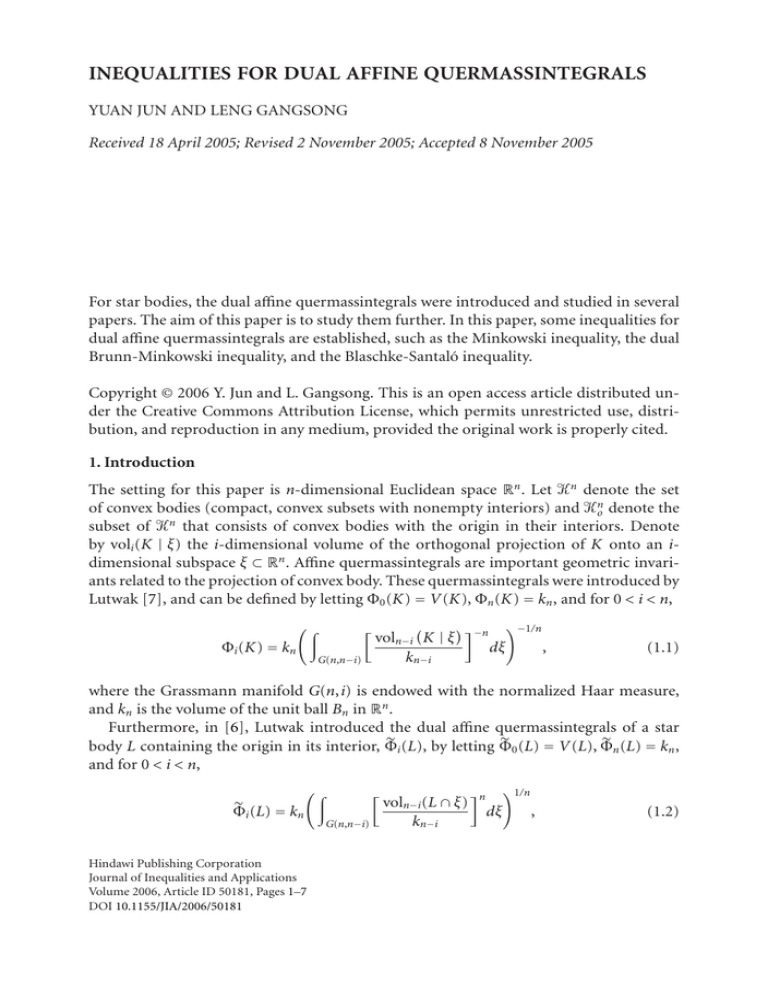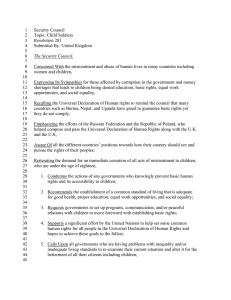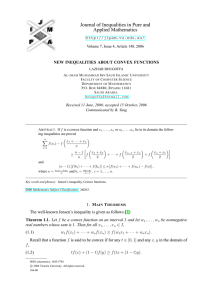INEQUALITIES FOR DUAL AFFINE QUERMASSINTEGRALS
advertisement

INEQUALITIES FOR DUAL AFFINE QUERMASSINTEGRALS
YUAN JUN AND LENG GANGSONG
Received 18 April 2005; Revised 2 November 2005; Accepted 8 November 2005
For star bodies, the dual affine quermassintegrals were introduced and studied in several
papers. The aim of this paper is to study them further. In this paper, some inequalities for
dual affine quermassintegrals are established, such as the Minkowski inequality, the dual
Brunn-Minkowski inequality, and the Blaschke-Santaló inequality.
Copyright © 2006 Y. Jun and L. Gangsong. This is an open access article distributed under the Creative Commons Attribution License, which permits unrestricted use, distribution, and reproduction in any medium, provided the original work is properly cited.
1. Introduction
The setting for this paper is n-dimensional Euclidean space Rn . Let n denote the set
of convex bodies (compact, convex subsets with nonempty interiors) and on denote the
subset of n that consists of convex bodies with the origin in their interiors. Denote
by voli (K | ξ) the i-dimensional volume of the orthogonal projection of K onto an idimensional subspace ξ ⊂ Rn . Affine quermassintegrals are important geometric invariants related to the projection of convex body. These quermassintegrals were introduced by
Lutwak [7], and can be defined by letting Φ0 (K) = V (K), Φn (K) = kn , and for 0 < i < n,
Φi (K) = kn
G(n,n−i)
voln−i K | ξ
kn−i
−1/n
−n
dξ
,
(1.1)
where the Grassmann manifold G(n,i) is endowed with the normalized Haar measure,
and kn is the volume of the unit ball Bn in Rn .
Furthermore, in [6], Lutwak introduced the dual affine quermassintegrals of a star
i (L), by letting Φ
0 (L) = V (L), Φ
n (L) = kn ,
body L containing the origin in its interior, Φ
and for 0 < i < n,
i (L) = kn
Φ
Hindawi Publishing Corporation
Journal of Inequalities and Applications
Volume 2006, Article ID 50181, Pages 1–7
DOI 10.1155/JIA/2006/50181
G(n,n−i)
voln−i (L ∩ ξ)
kn−i
1/n
n
dξ
,
(1.2)
2
Inequalities for dual affine quermassintegrals
where voli (L ∩ ξ) denotes the i-dimensional volume of intersection of L with an
i-dimensional subspace ξ ⊂ Rn .
Grinberg [4] proved that both the affine quermassintegrals and the dual affine quermassintegrals are invariant under volume-preserving affine transformations.
For star bodies, the dual affine quermassintegrals were studied in [3, 4, 7, 10]. The aim
of this paper is to study them further. For reader’s convenience, we try to make the paper
self-contained. This paper, except for the introduction, is divided into three sections. In
Section 2 we recall some basics about convex bodies, star bodies, and dual mixed volume.
In Section 3, we introduce the concept of the mixed p-dual affine quermassintegrals
and establish the Minkowski inequality for them (Theorem 3.1). As an application, the
dual Brunn-Minkowski inequality for the dual affine quermassintegrals is obtained.
In Section 4, we establish a connection between the affine quermassintegrals and the
dual affine quermassintegrals for a given convex body.
2. Notation and preliminary works
As usual, Sn−1 denotes the unit sphere, Bn the unit ball, and o the origin in Euclidean
n-space Rn .
Let K be a nonempty compact convex body in Rn , the support function hK of K is
defined by
hK (u) = max{u · x : x ∈ K },
u ∈ Sn−1 ,
(2.1)
where u · x denotes the usual inner product of u and x in Rn .
If K is a convex body that contains the origin in its interior, the polar body K ∗ of K,
with respect to the origin, is defined by
K ∗ = x ∈ Rn | x · y ≤ 1, y ∈ K .
(2.2)
For a compact subset L of Rn , which is star-shaped with respect to the origin, we will
use ρ(L, ·) to denote its radial function; that is, for u ∈ Sn−1 ,
ρ(L,u) = ρL (u) = max{λ > 0 : λu ∈ L}.
(2.3)
If ρ(L, ·) is continuous and positive, L will be called a star body.
Let on denote the set of star bodies in Rn containing the origin in their interiors.
Two star bodies K,L ∈ on are said to be dilatate (of one another) if ρ(K,u)/ρ(L,u) is
independent of u ∈ Sn−1 .
(L1 ,...,Ln ) is defined by
Let L j ∈ on (1 ≤ j ≤ n). The dual mixed volume V
(L1 ,...,Ln ) =
V
1
n
Sn−1
ρL1 (u)ρL2 (u) · · · ρLn (u)du.
(2.4)
(L1 ,i1 ;... ;Ln ,in ) for the dual mixed volume in which L j appears i j
We use the notation V
times.
xm is defined to be the usual vector sum of the
···+
If xi ∈ Rn , 1 ≤ i ≤ m, then x1 +
points xi , if all of them belong to a line through o, and 0 otherwise.
Y. Jun and L. Gangsong 3
Let Li ∈ on and ti ≥ 0, 1 ≤ i ≤ m, then
tm Lm = t1 x1 +
tm xm : xi ∈ Li
···+
···+
t1 L1 +
(2.5)
is called a radial linear combination.
The following elementary property of dual mixed volumes will be used later. For
K,L,L j ∈ on (1 ≤ j ≤ n − 1),
L1 ,...,Ln−1 ,K +
(L1 ,...,Ln−1 ,L .
L1 ,...,Ln−1 ,K + V
L = V
V
(2.6)
For K,L ∈ on , the Minkowski inequality for dual mixed volumes [3, page 373] states
(K,n − p;L, p)n ≤ V (K)n− p V (L) p ,
V
(2.7)
with equality if and only if K is a dilatate of L.
The above elementary results (and definitions) are from the theory of convex bodies.
The reader may consult the standard works on the subject [1, 3, 5, 9, 10] for reference.
3. The dual Brunn-Minkowski inequalities for dual affine quermassintegrals
In this section, we will prove the dual Brunn-Minkowski inequality for the dual harmonic
quermassintegrals. At first, we introduce the concept of mixed p-dual affine quermassintegrals.
Let K,L ∈ on , ξ ∈ G(n,i) and 0 ≤ p ≤ i. We define mixed p-dual affine quermassinte p,i (K,L). Let first V
p,i (K,L;ξ) by
grals, Φ
(K ∩ ξ,i − p ;L ∩ ξ, p).
p,i (K,L;ξ) = V
V
(3.1)
p,i (K,K;ξ) = voli (K ∩ ξ), for all 0 ≤ p ≤ n − i, and V
i,i (K,L) =
It is easy to verify that V
voli (L ∩ ξ), for all K.
p,i (K,L) by
Now we define the mixed p-dual affine quermassintegrals Φ
p,i (K,L) = kn
Φ
V p,n−i (K,L;ξ) n
G(n,n−i)
kn−i
1/n
dξ
.
(3.2)
i (K),
i (K,L), rather than Φ
1,i (K,L). It follows that Φ
p,i (K,K) = Φ
If p = 1, we will write Φ
i (L), for all K.
n−i,i (K,L) = Φ
for all 0 ≤ p ≤ n − i and Φ
For the mixed p-dual affine quermassintegrals, we have the following Minkowski inequality.
Theorem 3.1. Let K,L ∈ on and 0 ≤ i < n. If 0 ≤ p ≤ i, then
i (K)n−i− p Φ
p,i (K,L)n−i ≤ Φ
i (L) p ,
Φ
with equality if and only if K is a dilatate of L.
(3.3)
4
Inequalities for dual affine quermassintegrals
Proof. Let ξ ∈ G(n,n − i). By (2.7), we get
(K ∩ ξ, n − i − p;L ∩ ξ, p)
p,n−i (K,L;ξ) = V
V
(3.4)
≤ voln−i (K ∩ ξ)(n−i− p)/(n−i) voln−i (L ∩ ξ) p/(n−i) .
According to (3.4) and the Hölder integral inequality, we have
p,i (K,L) = kn
Φ
V p,n−i (K, L;ξ) n
≤ kn
kn−i
G(n,n−i)
G(n,n−i)
voln−i (K ∩ ξ)
kn−i
1/n
dμi (ξ)
n(n−i− p)/(n−i) voln−i (L ∩ ξ)
kn−i
1/n
np/(n−i)
dμi (ξ)
i (K)(n−i− p)/(n−i) Φ
i (L) p/(n−i) .
≤Φ
(3.5)
By the equality conditions of Hölder integral inequality and the Minkowski inequality
for dual mixed volumes, the equality of (3.3) holds if and only if K is a dilatate of L. As an application of Theorem 3.1, we have the following dual Brunn-Minkowski inequality for the dual affine quermassintegrals.
Theorem 3.2. Let K,L ∈ on and 0 ≤ i ≤ n − 1. Then
i (K)1/(n−i) + Φ
i (K +
i (L)1/(n−i) ,
L)1/(n−i) ≤ Φ
Φ
(3.6)
with equality if and only if K is a dilatate of L.
Proof. Let ξ ∈ G(n,i) and K,L ∈ on , it is easy to prove that
L) ∩ ξ = (K ∩ ξ)+
(L ∩ ξ).
(K +
(3.7)
In fact, for u ∈ Sn−1 ∩ ξ, we have
ρ(K + L)∩ξ (u) = ρK + L (u) = ρK (u) + ρL (u) = ρK ∩ξ (u) + ρL∩ξ (u) = ρK ∩ξ + L∩ξ (u).
(3.8)
By (2.6), (3.7), for M ∈ on , we have
M ∩ ξ,i − 1; (K +
1,i (M,K +
L;ξ) = V
L) ∩ ξ
V
M ∩ ξ,i − 1; (K ∩ ξ)+
(L ∩ ξ)
=V
(M ∩ ξ,i − 1; K ∩ ξ) + V
(M ∩ ξ,i − 1; L ∩ ξ)
=V
1,i (M,K;ξ) + V
1,i (M,L;ξ).
=V
(3.9)
Y. Jun and L. Gangsong 5
According to (3.2) and Minkowski integral inequality, we have
i (M,K +
L) = kn
Φ
L;ξ) n
V1,n−i (M,K +
kn−i
G(n,n−i)
= kn
1/n
dμn−i (ξ)
1,n−i (M,L;ξ) n
V1,n−i (M,K;ξ) + V
kn−i
G(n,n−i)
1/n
dμn−i (ξ)
i (M,K) + Φ
i (M)(n−i−1)/(n−i) Φ
i (K)1/(n−i) + Φ
i (M,L) ≤ Φ
i (L)1/(n−i) ,
≤Φ
(3.10)
L for M, and recall
with equality if and only if K and L are dilatate of M. Now we take K +
that Φi (K,K) = Φi (K); then Theorem 3.2 follows.
Remark 3.3. Theorem 3.2 is a dual of Lutwak’s inequality for affine quermassintegrals,
which was proved in [7]: let K and L be convex bodies in Rn and 0 ≤ i ≤ n − 1, then
Φi (K + L)1/(n−i) ≥ Φi (K)1/(n−i) + Φi (L)1/(n−i) ,
(3.11)
with equality if and only if K and L are homothetic.
4. More about the dual affine quermassintegrals
Let K be a convex body of constant width, K ∗ is the polar body of K. We proved that
among convex bodies of constant width, precisely the ball attains the minimal value of
n−1 (K ∗ ).
Φ
Theorem 4.1. Let K ∈ on . If
vol1 K | ξ = vol1 Bn | ξ ,
(4.1)
for all ξ ∈ G(n,1), then
n −1 K ∗ ≥ Φ
n−1 Bn∗ ,
Φ
(4.2)
with equality if and only if K = Bn .
Proof. For all u ∈ Sn−1 , (4.1) is equivalent to
h(K,u) + h(K, −u) = 2,
(4.3)
and the chord length of K ∗ in direction u satisfies
ρ K ∗ ,u + ρ K ∗ , −u ≥
4
= 2,
h(K,u) + h(K, −u)
where we have used the inequality between arthmetic and harmonic means.
(4.4)
6
Inequalities for dual affine quermassintegrals
Notice that if ξ ∈ G(n,1), then vol1 (K ∗ ∩ ξ) is just the chord length of K ∗ along ξ. By
(1.2), we have
n−1 K ∗ = kn
Φ
G(n,1)
= kn
1
nkn
vol1 K ∗ ∩ ξ
2
Sn−1
dξ
∗
1/n
n
∗
ρ K ,u + ρ K , −u
2
(4.5)
1/n
n
∗
n −1 B n .
≥ kn = Φ
du
Equality holds if and only if h(K,u) = h(K, −u) = 1, which implies K is a unit ball cen
tered at the origin.
The following theorem which establishes a connection between the affine quermassintegrals and the dual affin equermassintegrals generalizes the Blaschke-Santaló inequality.
Theorem 4.2. Let K be a centered convex body and 0 ≤ i < n. Then
i K ∗ Φi (K) ≤ kn2 ,
Φ
(4.6)
with equality if and only if K is an ellipsoid.
To prove the inequality (4.6), the following lemma will be needed.
Lemma 4.3 [8]. Let K ∈ on and ξ ∈ G(n,i). Then
K∗ ∩ ξ = K | ξ
∗
.
(4.7)
Proof of Theorem 4.2. Let s = n − i, and ξ ∈ G(n,s). By the Blaschke-Santaló inequality,
for the body K | ξ in ξ, we have
vols K | ξ
∗ vols K | ξ ≤ ks2 ,
(4.8)
with equality if and only if K | ξ is an ellipsoid in ξ.
According to Lemma 4.3, we obtain
Vs K ∗ ∩ ξ
ks
n
Vs K | ξ
≤
ks
−n
,
(4.9)
with equality if and only if K | ξ is an ellipsoid in ξ. We integrate both sides of inequality
(4.9) over G(n,s) and get
Φi K ∗
kn
n
≤
Φi (K)
kn
−n
.
(4.10)
This is the desired inequality
i K ∗ Φi (K) ≤ kn2 ,
Φ
(4.11)
with equality if and only if K is an ellipsoid. The equality condition follows from the
fact that, for s > 1, ellipsoid is the only body all of whose s-dimensional projections are
s-dimensional ellipsoids (see [3, page 95]).
Y. Jun and L. Gangsong 7
Remark 4.4. The case i = 0 of (4.6) is the well-known Blaschke-Santaló inequality.
Acknowledgments
The authors are most grateful to the referees for their helpful suggestions. This work
was supported in part by the National Natural Science Foundation of China. (Grant no.
10271071)
References
[1] T. Bonnesen and W. Fenchel, Theorie der konvexen Körper, Springer, Berlin, 1934.
[2] H. Federer, Geometric Measure Theory, Die Grundlehren der mathematischen Wissenschaften,
vol. 153, Springer, New York, 1969.
[3] R. J. Gardner, Geometric Tomography, Encyclopedia of Mathematics and Its Applications, vol.
58, Cambridge University Press, Cambridge, 1995.
[4] E. L. Grinberg, Isoperimetric inequalities and identities for k-dimensional cross-sections of a convex
bodies, London Mathematical Society 22 (1990), 478–484.
[5] K. Leichtweiss, Konvexe Mengen, Springer, Berlin, 1980.
[6] E. Lutwak, Dual mixed volumes, Pacific Journal of Mathematics 58 (1975), no. 2, 531–538.
, A general isepiphanic inequality, Proceedings of the American Mathematical Society 90
[7]
(1984), no. 3, 415–421.
, Inequalities for Hadwiger’s harmonic quermassintegrals, Mathematische Annalen 280
[8]
(1988), no. 1, 165–175.
[9] L. A. Santaló, Integral Geometry and Geometric Probability, Encyclopedia of Mathematics and Its
Applications, vol. 1, Addison-Wesley, Massachusetts, 1976.
[10] R. Schneider, Convex Bodies: the Brunn-Minkowski Theory, Encyclopedia of Mathematics and Its
Applications, vol. 44, Cambridge University Press, Cambridge, 1993.
Yuan Jun: Department of Mathematics, Shanghai University, Shanghai 200444, China
E-mail address: yuanjun@graduate.shu.edu.cn
Leng Gangsong: Department of Mathematics, Shanghai University, Shanghai 200444, China
E-mail address: gleng@staff.shu.edu.cn








